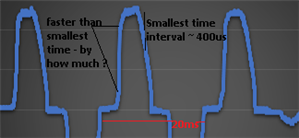Dutch of the Elm:<snip... >
I took it that the harmonics it would identify would be only theoretical, i.e. a way to describe the waveform mathematically but not actually altering how the waveform would sound.. Now I need to feed this through a speaker and compare to a pure sine wave, next time I have a chance.
Many thanks.
Hmm. the difference between a C on a violin (near triangle wave - the shape of the string under the bow), and the same C on a flute (near pure sine) is only the presence of harmonics with the right levels and phase relationship to the fundamental. To most of us they do indeed sound different ?
Edit
As always someone on youtube already has the same idea and you can listen to sine, square and triangle waves.
Waveforms with sharp edges can sound much more noticable than smooth edged ones.
Now this is due partly to the ear's response to harmonics, and partly to the fact that small diameter moving objects make poor low frequency speakers, (as the air has time to go round the moving part from the front to the back, rather than form a decent pressure difference ) but can be quite good treble ones, If you listen to that you tube video on small 'tinny' laptop speakers the difference is more marked than with larger HIFi ones.
The sampling artefact here is not the traditional aliasing, but a rise time that is so fast we cannot measure. The blocky pixels in your plot are giving a minimum resolvable time step of about 400us, to my uncalibrated eye - all we can say is that for part of the attack the rise time is faster than that.Now 400us is about the rise time of 1.1KHz ( the D or E couple of octaves above middle C ? note frequency table ) so there are at least components present at that frequency and may well be quite bit higher.
Attack is fast - you can get impact ionisation of plasma in air at almost the speed of sound. Decay takes longer, as you have to wait for positive and negative charges to recombine by a random walk process if there is not enough voltage gradient to sweep them out - and once the arc is struck the voltage gradient is quite low compared to striking. A sideeffect iof this is that although 50Hz arcs go out at the zero crossings, higher frequency ones are more like DC, as the plasma does not have time to go dark and is still lit and conductive during the current reversals - an RF arc is more of a scarey hiss than a snackle.
Dutch of the Elm:<snip... >
I took it that the harmonics it would identify would be only theoretical, i.e. a way to describe the waveform mathematically but not actually altering how the waveform would sound.. Now I need to feed this through a speaker and compare to a pure sine wave, next time I have a chance.
Many thanks.
Hmm. the difference between a C on a violin (near triangle wave - the shape of the string under the bow), and the same C on a flute (near pure sine) is only the presence of harmonics with the right levels and phase relationship to the fundamental. To most of us they do indeed sound different ?
Edit
As always someone on youtube already has the same idea and you can listen to sine, square and triangle waves.
Waveforms with sharp edges can sound much more noticable than smooth edged ones.
Now this is due partly to the ear's response to harmonics, and partly to the fact that small diameter moving objects make poor low frequency speakers, (as the air has time to go round the moving part from the front to the back, rather than form a decent pressure difference ) but can be quite good treble ones, If you listen to that you tube video on small 'tinny' laptop speakers the difference is more marked than with larger HIFi ones.
The sampling artefact here is not the traditional aliasing, but a rise time that is so fast we cannot measure. The blocky pixels in your plot are giving a minimum resolvable time step of about 400us, to my uncalibrated eye - all we can say is that for part of the attack the rise time is faster than that.Now 400us is about the rise time of 1.1KHz ( the D or E couple of octaves above middle C ? note frequency table ) so there are at least components present at that frequency and may well be quite bit higher.
Attack is fast - you can get impact ionisation of plasma in air at almost the speed of sound. Decay takes longer, as you have to wait for positive and negative charges to recombine by a random walk process if there is not enough voltage gradient to sweep them out - and once the arc is struck the voltage gradient is quite low compared to striking. A sideeffect iof this is that although 50Hz arcs go out at the zero crossings, higher frequency ones are more like DC, as the plasma does not have time to go dark and is still lit and conductive during the current reversals - an RF arc is more of a scarey hiss than a snackle.
We're about to take you to the IET registration website. Don't worry though, you'll be sent straight back to the community after completing the registration.
Continue to the IET registration site